Thousands in Adelaide CBD for historic Aboriginal-led Anzac Day Dawn Service and march
Thousands of people returned to the city to commemorate Anzac Day – including Lyall Ellers, 98, who marched alone because his “mates have all died”.
SA News
Don't miss out on the headlines from SA News. Followed categories will be added to My News.
Thousands have gathered on North Terrance to commemorate Australia’s service men and women for the first fully public Dawn Service since 2019.
But the event held special significance for another reason – it was also SA’s first Dawn Service led by Aboriginal people.
Thousands witnessed the historic event at the National War Memorial, headlined by an smoking ceremony, catafalque party and welcome to country.
WATCH THE DAWN SERVICE
WATCH THE MARCH
At least 450 SA Aboriginal veterans are known to have served and died in conflicts around the world since the early 1900s, including World War I and II and Vietnam, with this year’s service the most public recognition of their sacrifice.
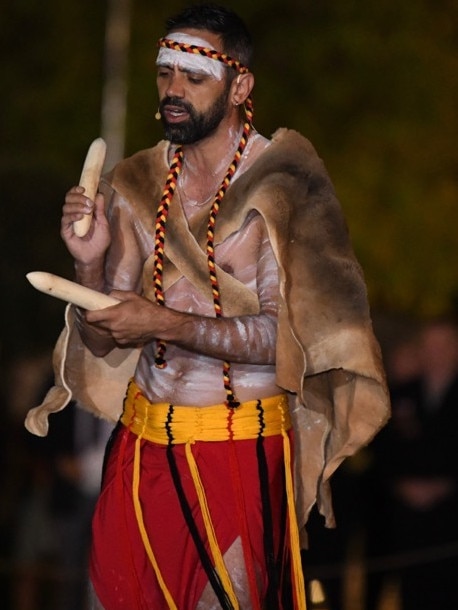
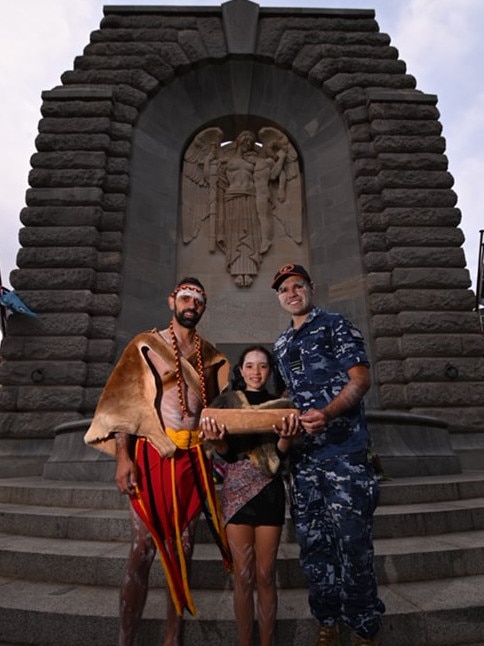
Public Dawn Services were scrapped in the past two years due to Covid restrictions and people turned out in full force this year to pay their respects to veterans who made the ultimate sacrifice.
Honouring Indigenous Australians was an integral part of the city’s first Dawn Service since the pandemic, with a smoking ceremony headlining the celebrations along with a welcome to country and traditional song performed by Kaurna leader Jack Buckskin and his daughter Mahleaha, 11.
Mr Buckskin, 35, said it was a special moment to share with his daughter.
“It was amazing,” he said. “I love standing with her.”
Mr Buckskin, a Kaurna and Narungga man, said the acknowledgment of Aboriginal people on Anzac Day was important.
“There were flavours (of Aboriginal culture) through the whole thing, which was nice.”
Dozens of people gathered at the Aboriginal War Memorial following the Dawn Service to continue the recognition of Aboriginal veterans.
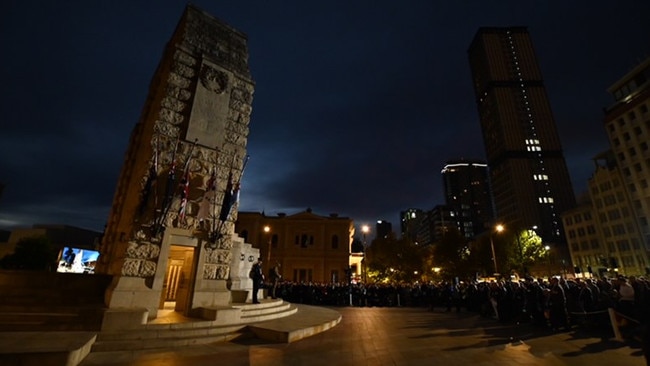
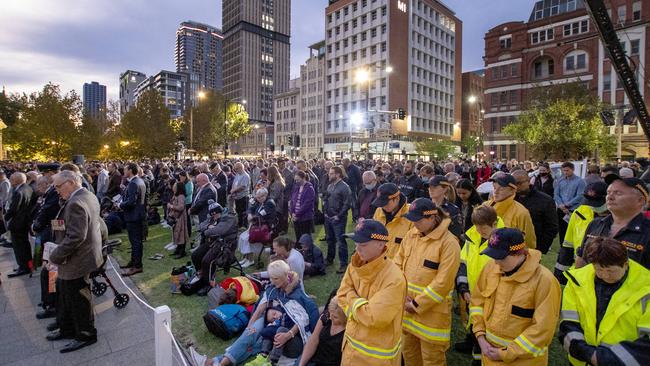
Darren Hincks, who was attending the memorial with brother Raymond, praised the recognition of Aboriginal service men and women.
“It’s important for our mob,” Mr Hincks said. “It’s small steps.”
Air Force Indigenous liaison officer Steven Warrior, who led the smoking ceremony with daughters Havanna, 10, and Wynter, 6, said he hoped Dawn Services would continue to celebrate Aboriginal veterans.
“One of the most cherished moments I have in this uniform is sitting down with veterans that we’ve got and hearing their stories and the challenges they’ve had to face,” he said.
“To reflect on that during this day and to be able to commemorate them … it’s a very special occasion. I think it’s something that we need to do.”
Thousands of people also took advantage of relaxed Covid restrictions to march in honour of those who made the ultimate sacrifice for their country.
Kicking off at 9.30, the march left the SA National War Memorial, with those in the march cheered on by friends and family.
Among those marching was 98-year-old Lyall Ellers who managed to complete three-quarters of the march unaided before being joined by partner Pamela Chapman.
Mr Ellers, who served in the Air Force in Papua New Guinea and Borneo during World War II, is the last living member of his Air Force squadron after the only other remaining veteran passed away around five years ago.
“I think about all my mates that aren’t here,” Mr Ellers said.
“I don’t know of anyone left, my mates have all died.”
Ms Chapman, 85, said she was privileged to be a part of the march with her partner.
“I didn’t know too much about the war, being that bit younger, but I’m so proud of him,” she said.
“I was with him all the way last year but I couldn’t make it today so I joined him halfway.”
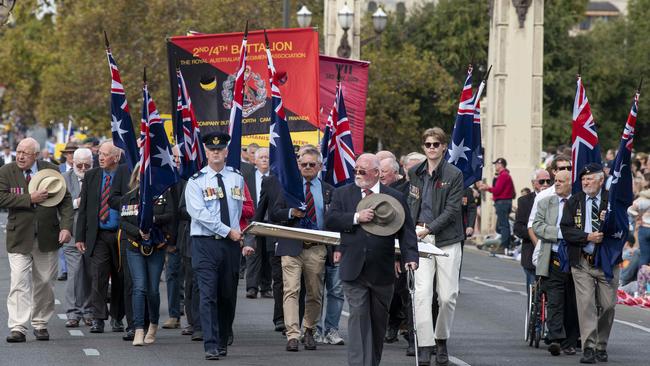
Kylie Johnson, of Semaphore, stood on North Terrace to remember her great-grandfather and grandfather, Lawrie Young.
Mr Young served in World War II helping boats ship supplies between Darwin and Papua New Guinea.
At age 19 while travelling by train to Puckapunyal, Mr Young threw a penny out of the window. It was wrapped in a letter with his address written on it and it landed in the Broadmeadows front yard of Ms Johnson’s grandmother Noreen.
Mr Young and his one-day wife became pen pals and continued to write to each other during the war.
Mr Young spent his 21st birthday hiding from a cyclone off Bougainville Island and when he returned after the war, he and Noreen married.
Ms Johnson has attended the march for over 30 years, despite her grandfather insisting only men were able to march.
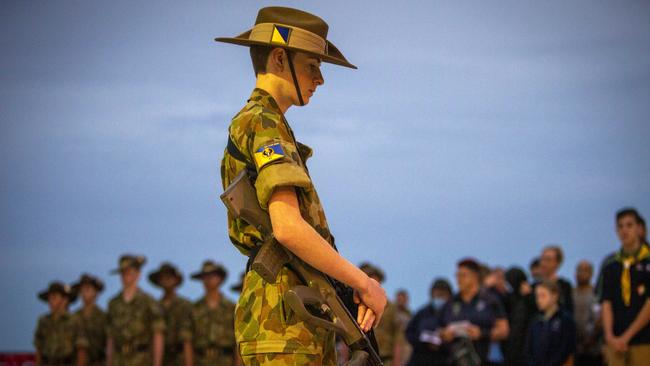
“We can’t forget,” she said. “It’s to remember them and the horrible times … to try and have empathy.
“This is a showcase of parentage and culture and should we forget, we’d have a bit of a catastrophe.”
Ms Johnson said she thinks about her grandparents’ remarkable story often.
“It’s stories like that, that would have led to all these children and their children’s’ children,” she said applauding the passing veterans.
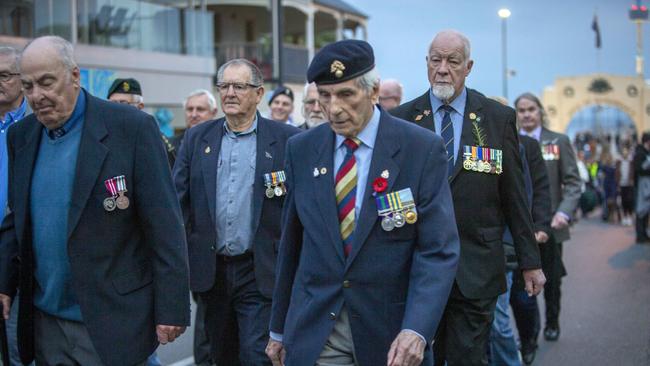
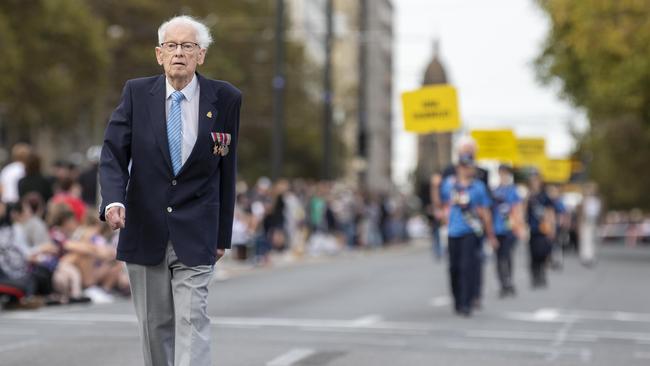
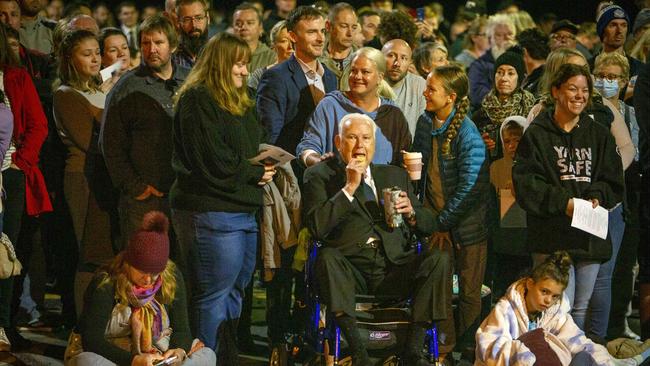
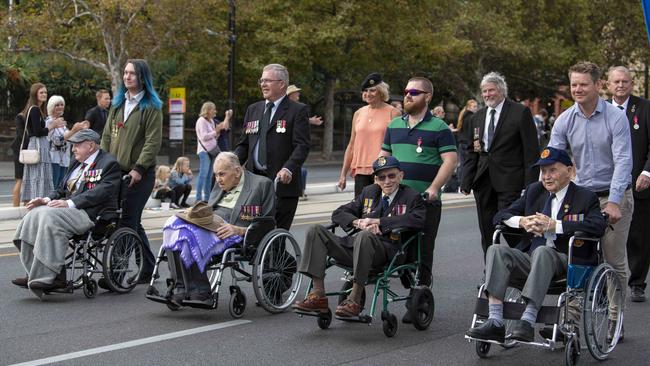
Chief petty officer Bradley Lynch, who has served in the navy for over 20 years and shared the morning with his daughter Alice, 2, was pleased to welcome the Dawn Service back.
“We came last year and there were a lot of barriers up and people weren’t sure whether to come or not, but this year it was great,” he said. “Everyone’s in it together.”
Mr Lynch also was paying tribute to family members who served in the British Army.
Kyzar Dean, 7, was up bright and early attending his second Dawn Service paying tribute to his uncle Ron who served in Vietnam.
Kyzar said it was important to “honour everybody’s memories” on Anzac Day.
He said his favourite part of the service was the Last Post.
Adelaide Crows AFLW star Ebony Marinoff was among the proud family members watching on as she cheered for grandfather Laurie Gillespie, 98, who served in the Army in Papua New Guinea during World War 2
“It’s very special,” said Ms Marinoff, who has been to the march every year since she was born. “The whole family comes out every year.”
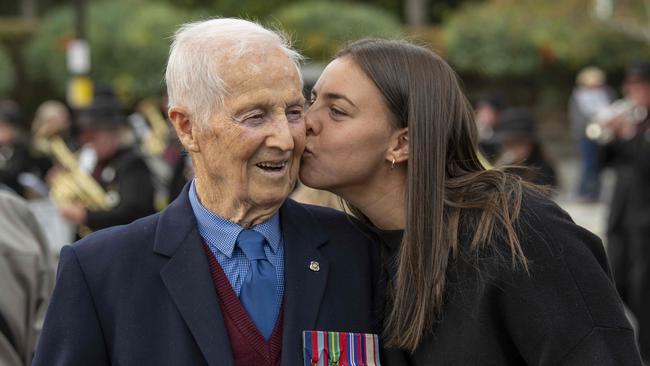
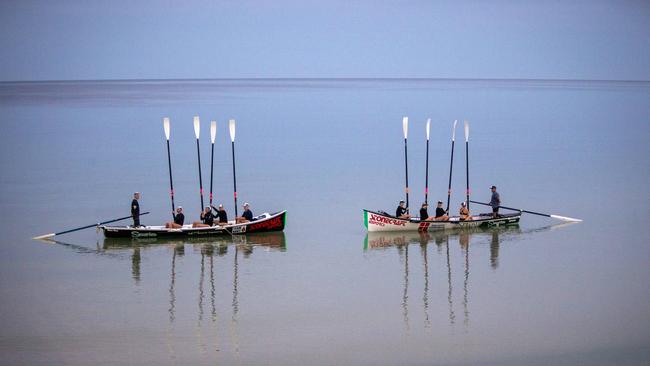
Many of the state’s political leaders paid their respects at the Dawn Service, placing wreaths at the foot of the memorial, including Premier Peter Malinauskas, Opposition Leader David Speirs, Senator Penny Wong, Finance Minister Simon Birmingham, Chief Justice Chris Kourakis, Governor Frances Adamson and Lord Mayor Sandy Verschoor.
Mr Malinauskas, who attended the service with wife Annabel and daughter Sophie, said the turnout exceeded the government’s expectations.
The dawn service is always important, regardless of where it is,” he said.
“The tradition in South Australia of honouring those who have made the ultimate sacrifice in the name of liberty and freedom is profound.
“To see such a large crowd here as we emerge out of the pandemic shows the Anzac spirit has well and truly survived Covid.”
Mr Malinauskas said honouring Aboriginal veterans was an important part of the dawn service.
“It is truly special, of course,” he said. “We know that a large number of Indigenous people lost their lives in the name of our country, their country, and to have that in a particular way this morning is unique and I think really special.”
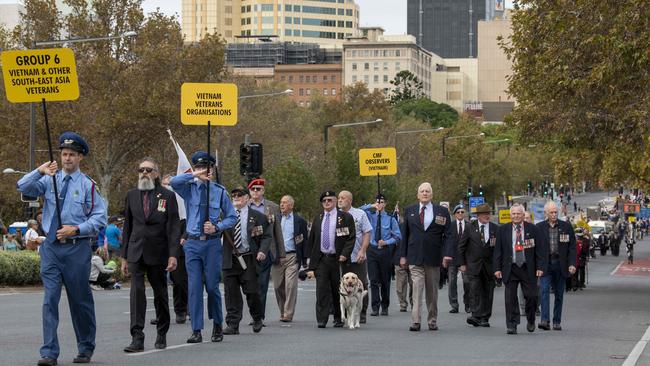
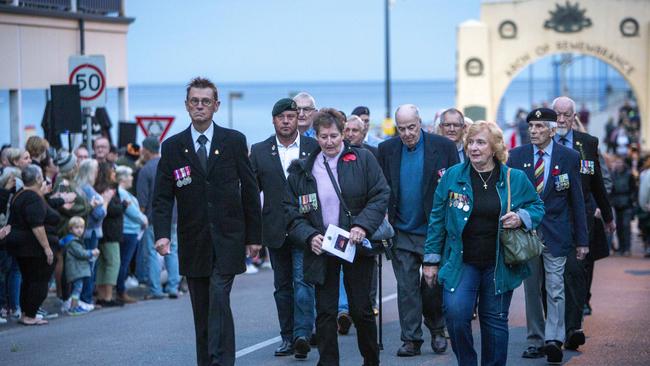
Adelaide’s youth hold Anzac Day eve vigil
Young South Australians have gathered on Anzac Day eve to commemorate the fallen at the biggest youth vigil in the state.
Volunteers from eleven organisations, including SES and Australian Army Cadets, stood in silence at the National War Memorial on North Tce.
17-year-old Jasmine Baker was thrilled to speak at the event, after winning the Premier’s Anzac Spirit School Prize in 2020. The Seacombe Gardens student submitted a research piece about her great grandfather who served during WWII in the Pacific.
“The Anzacs are a group of strong and determined individuals, and the resilience and sacrifice that they show is just something that is so unbelievable (and) something that we can really aspire to,” she said.
“The last line of the ode is ‘we will remember them’ and it encourages the continuation of their legacy a bit more than ‘lest we forget’.”
Miss Baker, who is currently in Year 12 at the Australian Science and Mathematics School, said her research and education has taught her about historic events including the Darwin bombings.
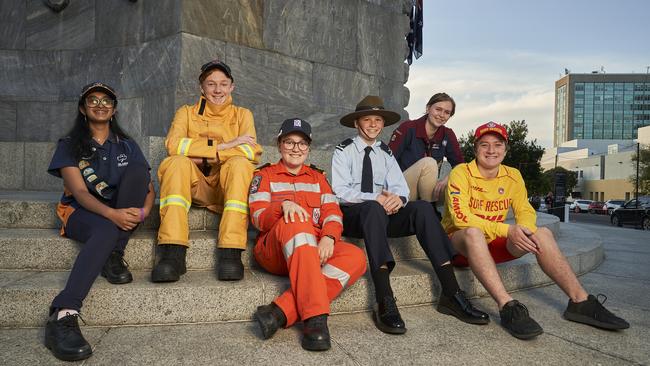
“The great detail that many people think is that it only happened over one day but the whole bombing consisted of about 64 air raids over quite a few months,” she said.
Nick Kleinig, 16, has been volunteering at the CFS in Port Lincoln since he was 11-years-old, and flew to Adelaide with his mother to pay his respects.
“It means a lot to me knowing that I’m playing a part in it and showing respect for remembering the fallen,” he said.
“I would like to see more youth involved because there’s genuinely limited groups that do it.
But on the other hand, it’s excellent the amount of people that participate.”
Chairman of the event, Vince Scotland, who served in the Middle East, said it was “quite emotional to see these young people participate in commemoration”.
“It’s great to see young people challenging themselves and stepping outside the comfort zone and commemorating the fallen,” he said.
- Tia Ewen




